On our sixth trip to Europe, my wife Bea and I were finally able to visit the Waterloo battlefield. After attending Le Mondial de la Figurine, the Historical Figure World Expo '96 in Paris, we took the high speed (180 mph!) train from Paris to Brussels. Many visitors to Waterloo go to Brussels first. You will be in good company, King George IV and Tsar Alexander I stayed there while visiting the battlefield. Fortunately, Brussels is one of the least expensive cities in Europe. A meal in a good restaurant in Brussels costs about half what it does in Paris.
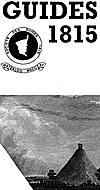 There are two ways to see the battlefield. First, you can book a regular guided tour with Les Guides 1815, Centre du Visiteur, Route du Lion 252, 1420 Braine-l'Alleud, Belgium. It costs about $39 US per person. In addition to Waterloo you will get to see the little jewel-box castle, Gaasbeek. It alone is worth the price. Second, you can take a "W" bus from the t'Rooupe square in central Brussels and tour on your own. We did both and spent two days at Waterloo.
There are two ways to see the battlefield. First, you can book a regular guided tour with Les Guides 1815, Centre du Visiteur, Route du Lion 252, 1420 Braine-l'Alleud, Belgium. It costs about $39 US per person. In addition to Waterloo you will get to see the little jewel-box castle, Gaasbeek. It alone is worth the price. Second, you can take a "W" bus from the t'Rooupe square in central Brussels and tour on your own. We did both and spent two days at Waterloo.
If you tour on your own, tell the bus driver that you want to get off at "Waterloo Eglise" (buses leave every half hour). The trip costs just under $3 US. After a short drive through suburbs you will arrive across the street from the Wellington Museum in the village of Waterloo. The actual battlefield lies two miles south.
The Museum is housed in the old posting inn that the Duke used as his headquarters. There are many interesting items on display including well done dioramas using 54mm model soldiers. The best of these is of the French assault on the farm of Hougoumont. There are, of course, many of the Duke's personal items and the bed in which Wellington's aide Lt.-Col. Gordon died. In an attached building is a fine collection of Napoleonic uniforms.
After the Museum
After the Museum, take the bus again and tell the driver that you want to get off at "le Lion" (another $1 US). You will be dropped off in sight of the "Butte de Lion", the massive artificial hill erected on the site where the Prince of Orange was wounded.
The Waterloo Visitors Center with the panorama painting of the battle is a quarter mile walk. The Center also has a "spectacular" (two interesting movies for about $7 US per person), and sells tickets to the Lion Mound (yes, you have to pay to climb the hill) and the panorama painting. You can get your Lion Mound and Panorama tickets as a package deal.
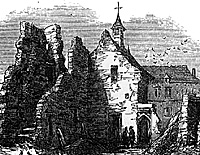 Rumors had the big circular painting in bad shape. Fortunately, the local government has completely refurbished it. The panorama shows the battle at the moment of the French cavalry charge. Your view point is right behind Captain Mercer's Royal Horse Artillery battery's position. Don't miss it. [Lachouque's book Waterloo (1975) has photographs of the panorama.]
Rumors had the big circular painting in bad shape. Fortunately, the local government has completely refurbished it. The panorama shows the battle at the moment of the French cavalry charge. Your view point is right behind Captain Mercer's Royal Horse Artillery battery's position. Don't miss it. [Lachouque's book Waterloo (1975) has photographs of the panorama.]
Leaving the building, turn left and take the narrow lane called "Chemin 1815". Fields bordering the lane are planted with wheat and sugar beets and look about as they did in 1815. Walk along the base of the Lion Mound and you come out on the ridge line that was the British main line of resistance.
Rolling Terrain
The country around Waterloo is "rolling" terrain, very much like that in the vicinity of Dayton, Ohio. I thought that references to ridge lines and hills, reverse slopes, etc., were exaggerated a bit and that the country was probably pretty flat. I was wrong. There is in fact a very pronounced ridge line with a steep slope going down into a shallow depression to the northwest. [This ridge line was more pronounced before the removal of so much earth to create the Lion Mound several years after the battle. The erection of the monument also obliterated part of the sunken road.] Troops drawn up here would indeed be sheltered from French artillery fire coming from south of this position.
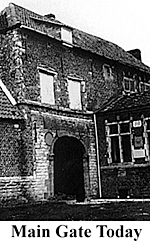 On your walk you come to a monument to the French cavalry and then another stone that marks the position of Captain Mercer's battery, your vantage point when viewing the panorama.
On your walk you come to a monument to the French cavalry and then another stone that marks the position of Captain Mercer's battery, your vantage point when viewing the panorama.
Our feeling, while walking down this lane, was similar to that we had near the Bloody Pond at Shiloh or on the bridge across Antietam Creek: A tremendous event took place where we were standing and an emotional echo of that event seems to linger at the site.
If you continue down the lane about another 1000 yards you arrive at the farm of Hougoumont. This is a working farm, and while the owner does not object to visitors walking on the lanes, do not enter the farm itself. [In June, on the anniversary of the battle, the farms and other private areas are more tolerant of visitors.]
The defense of Hougoumont by the British Guards and waggon train troops (the latter, along with the German defenders, are usually forgotten or ignored) is described elsewhere in this issue. The main building, tower, coach shed, cow shed, east stable and east gate into the walled garden were destroyed during the battle, and the wooded area has been almost completely eliminated. Otherwise, the gardener's house and surrounding buildings such as the main barns are much the same as they were 182 years ago.
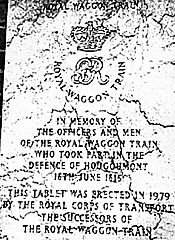
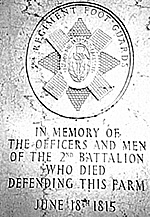 The garden wall in the front of the farm, flanking the main gate, is still standing. It is, however, at least two feet lower than it was in 1815. The British soldiers knocked loopholes in the wall to fire through and afterwards the upper portion was knocked down. There are several memorial stones in the wall and buildings. Inside the farm is the chapel, the only remaining portion of the original main building. It is still a consecrated church and has a memorial to the soldiers who fell here.
The garden wall in the front of the farm, flanking the main gate, is still standing. It is, however, at least two feet lower than it was in 1815. The British soldiers knocked loopholes in the wall to fire through and afterwards the upper portion was knocked down. There are several memorial stones in the wall and buildings. Inside the farm is the chapel, the only remaining portion of the original main building. It is still a consecrated church and has a memorial to the soldiers who fell here.
Return
Return now to the Visitors Center and the cluster of monuments next to a busy highway. Directly in front of you is La Haye Sainte farm; a strongpoint like Houg-oumont, but much smaller and one which fell to the French. The corner next to the main gate and small orchard are both gone, but it has not significantly changed otherwise. On the south side of the farm the walls still show the hits from French cannon balls, especially the ricochet shots about knee-high level. The road is heavily traveled; be careful crossing!
Like Hougoumont, La Haye Sainte is a working farm. Do not enter! Up the road, past the farm, is Napoleon's headquarters at La Belle Alliance with its Wounded Eagle, a beautiful and poignant monument to the Imperial Guard. To your left is the village of Plancenoit through which the Prussians attacked the French at the close of the day.
Waterloo is commercialized, but less so than Gettysburg. On the bus ride back to Brussels we remembered an exciting and moving experience, recommended for every student of the Napoleonic Wars who wants to really appreciate and understand the momentous event that was Waterloo!
Hougoumont
-
Introduction
First and Second French Assaults
More French Assaults
In Retrospect (analysis)
Hougoumont Today
French Line Grenadier (profile)
British Foot Guards (profile)
Excerpt from Lt. Ellison, 1st Foot Guards
Order of Battle
Diorama
Back to Table of Contents -- Napoleon #7
Back to Napoleon List of Issues
Back to Master Magazine List
© Copyright 1997 by Emperor's Press.
This article appears in MagWeb (Magazine Web) on the Internet World Wide Web.
The full text and graphics from other military history magazines and gaming magazines are available at http://www.magweb.com